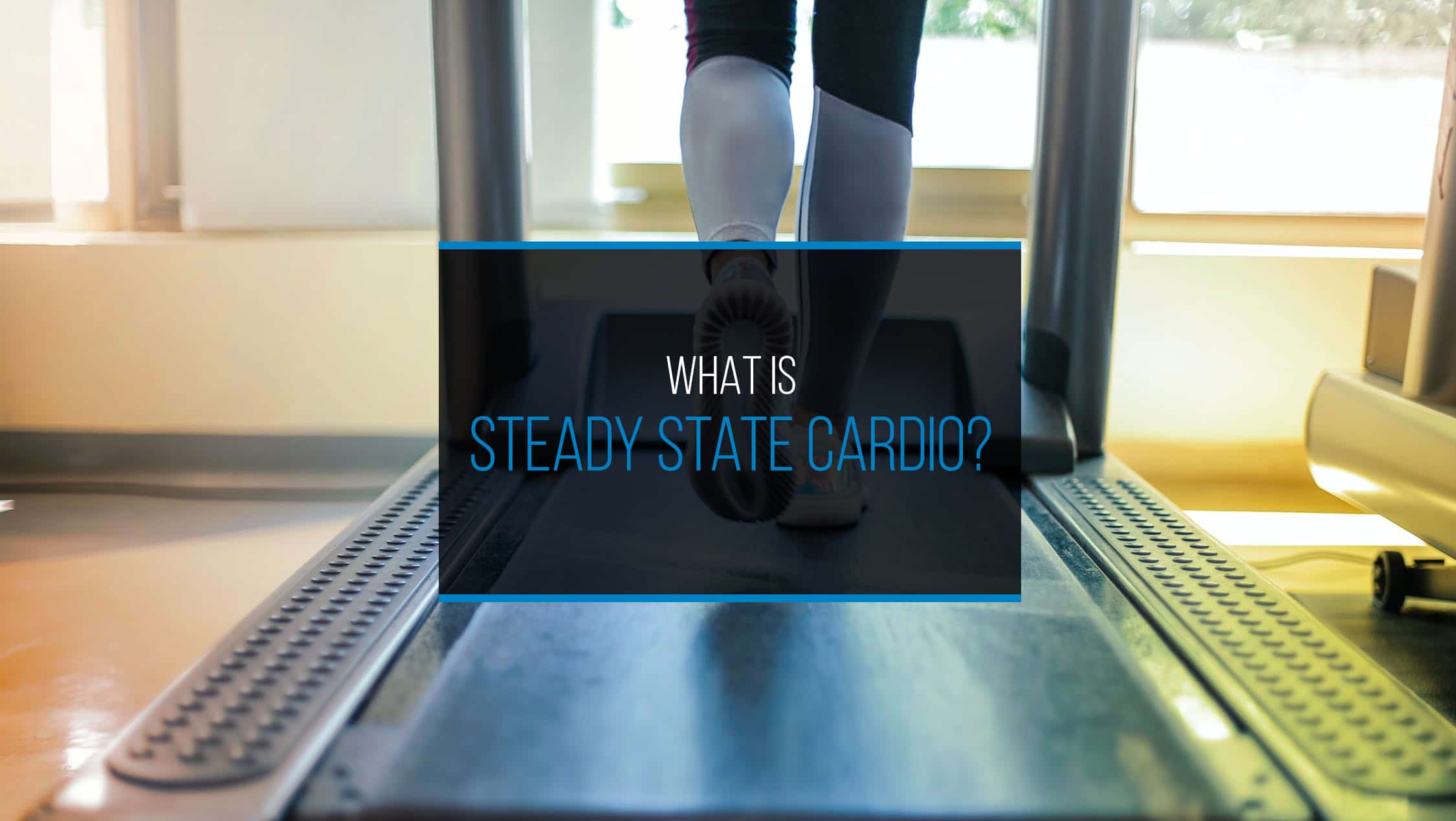Cardio has been popular among fitness gurus since the beginning of training programs. It aids weight loss by burning calories and improving fitness by strengthening your heart, lungs, and muscles.
But recently, you might have come across the term “steady state cardio.” For starters, don’t worry. It isn’t a newly invented workout regimen that would take you weeks to learn. Instead, steady state cardio is a workout you do continuously at a steady pace for an extended period. It is excellent for building endurance, losing weight, and improving your overall health.
Steady state cardio is a simple form of cardio where you do not have to over-exert yourself. This limits the amount of time you require to recover and reduces the risk of complications like injuries and cramps.
Any cardiovascular activity that you can keep doing without rest for a period of 20 to 60 minutes at a fixed intensity level is what you call steady state cardio.
Moreover, the energy you exert doing steady state cardio should only be about 60-70% of your total energy. This, in turn, means your heart rate should beat at about 60-70% of its maximum rate.

What Are the Benefits of Steady State Cardio?
Steady state cardio has to offer several benefits. It is an innovative workout that accommodates different fitness levels.
- Beginner-Friendly
Because of its gentle nature, steady state cardio is ideal for beginners. So, if you’re new to the fitness world, this is the ideal workout for you. Unlike its more challenging counterparts, such as high-intensity interval training (HIIT), steady state training has a more straightforward routine that everyone can follow.
Still, steady state training provides endorphins and a sense of accomplishment. And, the best part is that you don’t have to put up with much suffering to reap the rewards.
- Boosts Endurance and Promotes Weight Loss
By training with steady state cardio, you are preparing yourself to endure more strenuous workouts. Endurance is an excellent attribute to possess, especially if you’re training for a long-distance race or simply want to outrun a friend.
It is also a great workout since it helps you become more efficient and prepares you for more intense workout programs like HIIT.
- Better Recovery
Steady state cardio allows you to remain active while recovering. If you work out constantly, your body must recover adequately to get the best result out of your training.
With this non-strenuous training, you can exercise at a leisurely pace. This means the chances of you getting injured or fatigued are drastically reduced, thereby improving your recovery rate and time.
- Versatility
You can practice steady state cardio as training for various fields. Athletes in many sports use this training method. For example, it can be beneficial for long-distance runners, cyclists, or triathletes.
However, if you’re looking to go faster or gain some serious muscle mass, you must focus on speed and strength training. In this case, you could use steady state cardio as a secondary training program.
- Socially-Friendly
If you enjoy having chats with friends, family, or even your workout buddy, you’ll get a kick out of this workout. The pace of steady state cardio allows you to have enough breath in your lungs to have all the conversations you want.
However, this is not recommended since if you have enough energy to talk for an extended period, you may not be putting enough energy into the workout itself.
Disadvantages of Steady-State Cardio

Despite all its resounding benefits, there are some drawbacks to steady state cardio you might want to know about.
- Slower Results
You will indeed get fit and lose weight while doing this form of cardio. However, due to the lower rate of energy exerted, you may end up with a slower result than someone who has gone through a more intensive routine.
- Time Consuming
If you hope to lose a lot of weight doing steady state cardio, you must perform the exercise for an extended period. It can get challenging to squeeze over an hour of activity into a packed schedule.
- Repetitive Stress Injuries
Doing the same movements for an extended period can cause injuries in the joints that perform these movements repetitively. This can worsen if you want to lose a lot of weight because you will need to work out for much longer.
You can reduce your chances of hurting yourself by doing the proper stretches before the start of your workout session.
- Prolonged Stress
Exposing your body to prolonged stress can hinder you from losing weight and also increase muscle tissue damage.
Types of Steady-State Cardio
Most people believe any activity that makes your heart beat faster is considered cardio, but that could not be farther from the truth. Activities like lifting a heavy box can make your heart beat faster, but that doesn’t make it a cardiovascular workout.
For an activity to be classified as cardio, yes, it has to make your heart rate increase. But, it also has to improve how your heart, lungs, and circulatory system function.
Unlike HIIT, which already has a definite set of workouts to undergo, steady state cardio makes room for diversity. You can perform your steady state cardio on a treadmill, rowing machine, stair climber, or even dance your way around the room!
If you’re looking for something more adventurous, you could always take your workout outside. You can go jogging, hiking, biking, or go easy by taking a walk (but be careful not to go too easy).
Implementing Steady State Cardio

As you know, steady state cardio is done to build endurance and lose weight, but if you do it at a pace too fast or too slow, you won’t get the desired results.
If you go too fast, you may end up burning out too quickly. This means you won’t get enough time to achieve the results you want. Also, if you do not put in enough energy during your workout, the chances of getting fit are slim to none, even if you work out for 90 minutes every day.
Therefore, you need to push yourself to improve your endurance, burn calories, and tone your muscles. Regardless, be careful not to put in too much energy, except if you’re aiming for a more intensive program like the HIIT.
You can use your heartbeat to measure your intensity. Properly doing steady state cardio should put your heart rate between 60% to 70% of its maximum rate per minute. Estimate your maximum heart rate by subtracting your age from 200. Calculate 60% and 70% of your maximum rate to get the range for your next steady cardio session.
To measure your heart rate during the workout, put two fingers over your neck pulse or your palm over your heart. Count your heartbeat for ten seconds and multiply the value by six, and that’s your answer! If it’s within the 60% to 70% range, you’re good. If not, push harder or go slower, as needed.
For best results, you should perform your steady-state cardio three to five times a week.
What is HIIT?
HIIT (High-Intensity Interval Training) is a form of cardiovascular exercise that involves pushing your body out of its comfort zone for a few minutes. With HIIT, you’re attempting to exert about 90% percent of your total energy, which means your heart rate will work at 80-90% of its total rate.
After each set, you’ll get a recovery period that varies depending on what you prefer. You have to get your heart rate to 30-40% of its total rate during this period.
When you have gone through the recovery period, you begin another intense set and perform this workout and recovery cycle for 10 to 20 minutes. The time you take depends on your fitness level, your usual schedule, and what you hope to achieve from the workout.
Differences Between Steady-State Cardio and HIIT
Both HIIT and steady state cardio are beneficial for your overall health. However, they have differences that will probably make you lean towards one or the other.
- Aerobic vs. Anaerobic: Steady state cardio is primarily aerobic, requiring oxygen to perform cardiovascular activities. Also, the workout mostly burns fat. On the other hand, HIIT is anaerobic, which means it doesn’t always require oxygen, and you burn stored carbohydrates.
- Recovery: Steady state cardio allows for proper recovery while HIIT does not. The lack of recovery could quickly lead to injuries or burnout. The lack of adequate recovery can also affect your nervous system.
- Calories: Due to its easy-going nature, you tend to burn fewer calories doing steady state cardio than HIIT, which is more intensive.
- Time: Steady state training generally takes more time to complete. This is because HIIT is so intensive that you’re likely to get results quicker. So if you want to see similar results in steady state cardio, you have to continue the workout much longer.
Conclusion
Working out is never easy. It takes hard work, dedication, and consistency. Yes, steady state cardio is a more accessible alternative to other workout methods, but you won’t see results if you do not put in the effort.
In conclusion, make sure to stay committed to your cardio workout. We wish you luck on your journey to a healthier lifestyle!

